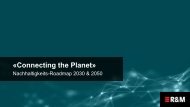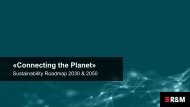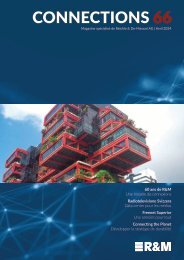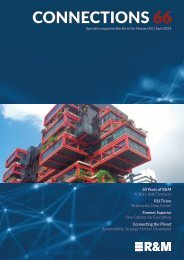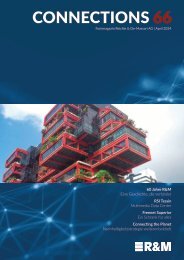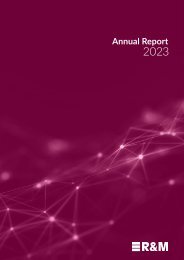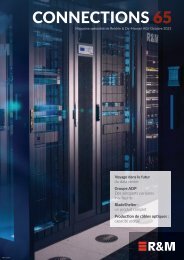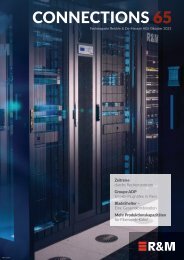CONNECTIONS_55-e
R&M customer magazine, Connectivity, Cabling, Fiber Optica, Copper
R&M customer magazine, Connectivity, Cabling, Fiber Optica, Copper
You also want an ePaper? Increase the reach of your titles
YUMPU automatically turns print PDFs into web optimized ePapers that Google loves.
Trends<br />
5G Networks<br />
Diversity as a Challenge<br />
050.6695<br />
In the future, everyone should be able to connect with everyone else and every device,<br />
every sensor and every machine get in contact with each other. The fifth-generation<br />
cellular phone network (5G) adapts to suit the particular communication requirements.<br />
This is just as true of security- and time-critical<br />
communication between vehicles or<br />
manufacturing plants as of the remote control<br />
of coffee machines using a cell phone. At the<br />
same time, videos in 4K format and virtual<br />
reality (VR) scenarios can be transmitted<br />
without error. Existing network infrastructures<br />
would break down with such a cocktail<br />
of applications. 5G networks adjust the infrastructure<br />
and performance of the relevant<br />
application.<br />
The International Telecommunication Union<br />
(ITU) has specified three application groups<br />
for 5G networks:<br />
– ultra-Reliable and Low Latency Communications<br />
(uRLLC) are digital industrial<br />
applications with high security and latency<br />
requirements over short distances. Example:<br />
automatic control of vehicles.<br />
– enhanced Mobile Broadband (eMBB) is<br />
designed to transmit broadband streaming<br />
applications. Example: mobile video and VR.<br />
– massive Machine Type Communications<br />
(mMTC) is to provide considerable range<br />
with low energy consumption and a low<br />
data rate for an exponentially growing<br />
number of connected devices. Example:<br />
sensors.<br />
A simple update from LTE to 5G would lead to<br />
a very complex and expensive infrastructure.<br />
The solution delivers a new architecture with<br />
technologies such as end-to-end network<br />
slicing, which permits the operation of exclusive<br />
virtual networks.<br />
One possible approach is based on a three-layer<br />
data center infrastructure: distributed edge<br />
data centers close to the cellular phone<br />
network base stations, local as well as regional<br />
050.6696<br />
Dr. Andrés Ferrer<br />
Innovation Project Manager<br />
andres.ferrer@rdm.com<br />
data centers. They are all equipped with hardware<br />
for the three application classes and are<br />
based on a mutual fiber optic infrastructure,<br />
best of all with wavelength division multiplexing<br />
technology. Upgrades on Demand are then<br />
possible without much effort.<br />
Setting up a 5G network will cost around one<br />
and a half times as much as a 4G network.<br />
Depending on the existing infrastructure,<br />
around one and a half to three times as many<br />
base stations and two to three times more<br />
optical fibers are required. With support from<br />
R&M, these challenges can be overcome.<br />
050.6675<br />
Dr. Peter Cristea | Head of Corp.<br />
Technology and Innovation<br />
peter.cristea@rdm.com<br />
24 10I2018–<strong>55</strong> <strong>CONNECTIONS</strong>






